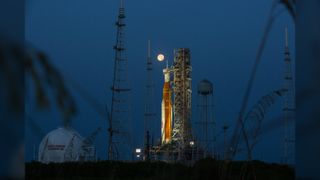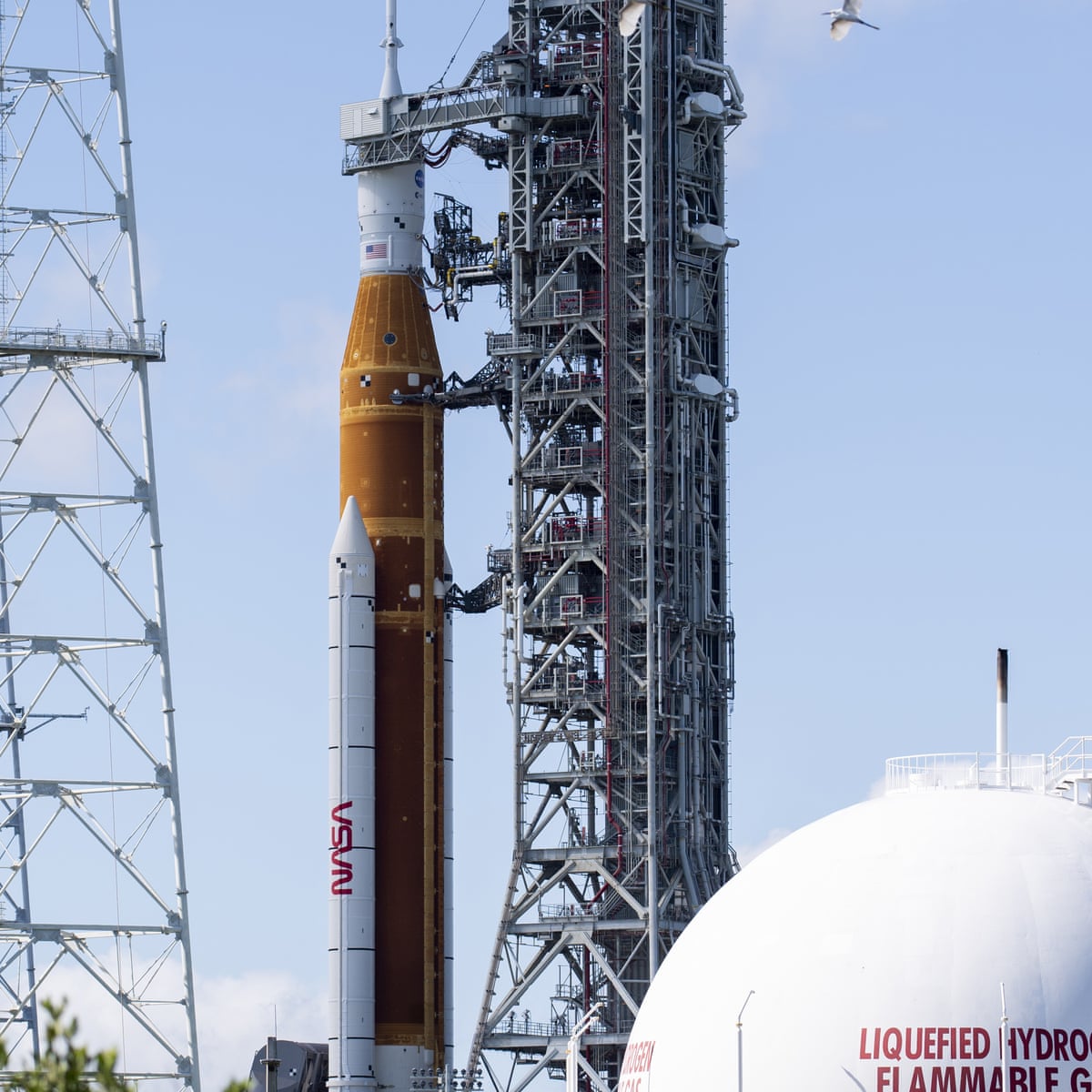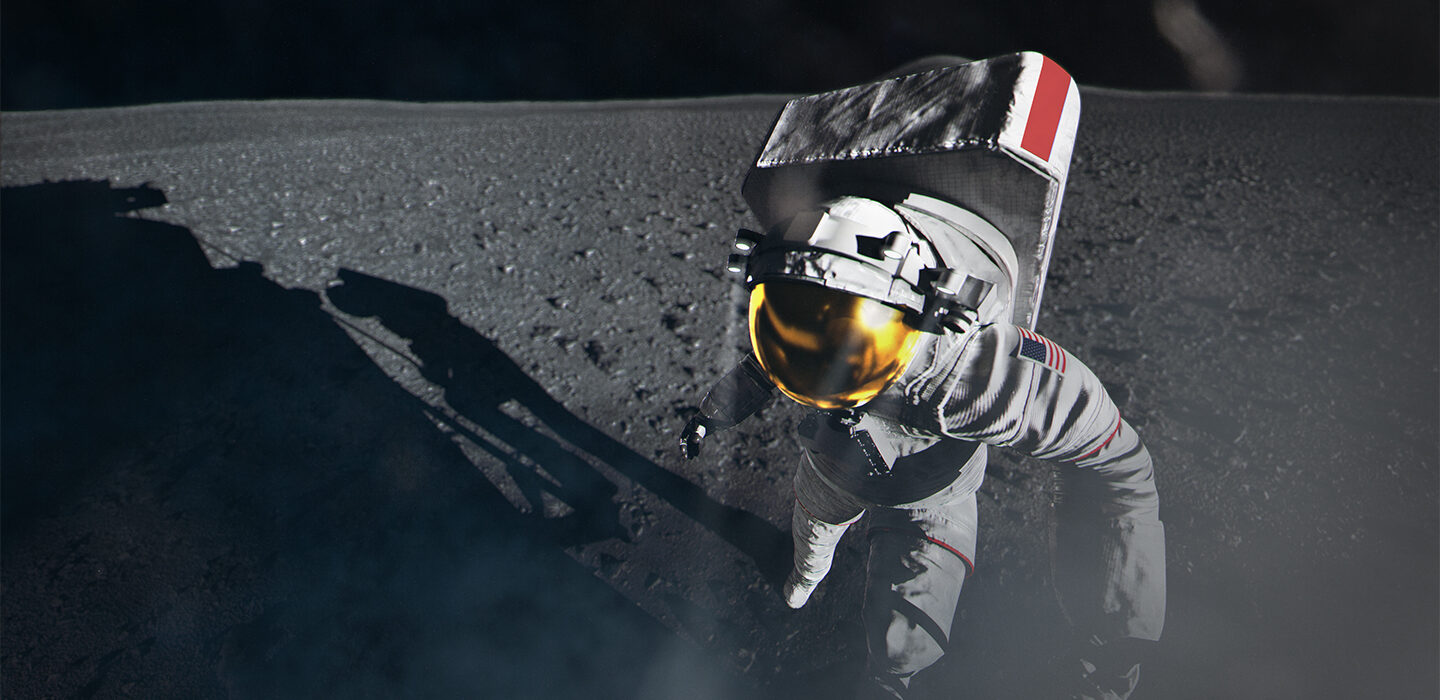Basic information about the Artemis program’s Space Launch System and Orion capsule.

A full Moon is in view from Launch Complex 39B at NASA’s Kennedy Space Center in Florida on June 14, 2022 with the Artemis I Space Launch System (SLS) and Orion spacecraft, atop the mobile launcher. The first in an increasingly complex series of missions, Artemis I will test SLS and Orion as an integrated system prior to crewed flights to the Moon. (Image credit: NASA)
The Artemis mega moon rocket is NASA’s latest and most powerful launch vehicle, intended to return astronauts, robots, and supplies to the moon for the first time in more than 50 years. It consists of a multistage rocket called the Space Launch System (SLS), which can carry various additional modules atop it, such as the Orion crew vehicle that houses astronauts during flight.
On Nov. 16, 2022, the SLS achieved liftoff for the first time, blasting off from NASA’s Kennedy Space Center in Florida at 1:47 a.m. ET. After months of delay and three aborted attempts at launch, the rocket finally took off. Shortly after, the Orion crew capsule detached for an unmanned, 26-day mission to the moon and back. The capsule reentered Earth’s atmosphere and successfuly splashed down off the coast of Baja California, Mexico on Dec. 11, 2022. With that, phase one of NASA’s Artemis mission — which will eventually return humans to the moon for the first time in more than 50 years — officially concluded.
The SLS is an outgrowth of a previously planned rocket called Ares V, a heavy-lift two-stage vertically stacked launch system capable of carrying about 287,000 pounds (130,000 kilograms) to low Earth orbit or 143,000 pounds (65,000 kg) to the moon, according to NASA(opens in new tab). Ares V was part of the Constellation program, an initiative, started during the George W. Bush administration, that intended to return people to the moon, according to the space agency(opens in new tab).
Constellation was deemed too expensive, but in 2010, President Barack Obama signed the NASA Authorization Act of 2010 into law, directing NASA to create an Ares V-like rocket called the Space Launch System, according to The Planetary Society(opens in new tab). Although the SLS is intended for use in crewed missions, the Artemis mission to send humans beyond low Earth orbit for the first time since 1972 has suffered numerous delays.
LS is a super heavy-lift launch vehicle capable of taking astronauts to destinations all over the solar system, including the moon and Mars, according to NASA(opens in new tab). It can be organized into several evolvable and increasingly powerful configurations, allowing the agency to take on ever more ambitious missions.
The rocket consists of a core stage towering more than 212 feet (65 meters), with a diameter of 27.6 feet (8 m). When capped by the Orion crew capsule, the core stage will stand 322 feet (98 m) tall — higher than the Statue of Liberty — and weigh 5.75 million pounds (2.6 million kg). Along with two solid rocket boosters strapped to its side, the SLS can reach speeds of 24,500 mph (40,000 km/h) — fast enough to escape Earth’s gravity and reach the moon or beyond.

Ahead of NASA’s Artemis I flight test, the fully stacked and integrated SLS rocket and Orion spacecraft will undergo a wet dress rehearsal at Launch Complex 39B to verify systems and practice countdown procedures for the first launch. (Image credit: NASA/Aubrey Gemignani)
The core stage is powered by four RS-25 engines originally used to launch the space shuttle. These engines utilize liquid oxygen and liquid hydrogen and, with the additional solid rocket boosters, provide 8.8 million pounds (4 million kg) of thrust, surpassing the space shuttle system’s 7.8 million pounds (3.5 million kg) of thrust, according to the Houston Space Center(opens in new tab).
Under its initial Block 1 configuration, the SLS can ferry 59,500 pounds (27,000 kg) to the moon, according to NASA. The next configuration, Block 1B crew, will add a powerful Exploration Upper Stage that will provide an additional 97,000 pounds (44,000 kg) of thrust to the rocket and make it taller than the Saturn V rocket that carried Apollo astronauts to the moon. Block 1B crew can send 83,700 pounds (38,000 kg) to deep space, allowing researchers to bring supplies and experiments to Mars or beyond.
The most advanced currently planned configuration, called Block 2, will provide 9.5 million pounds (4.3 million kg) of thrust and will be able to lift more than 101,400 pounds (46,000 kg) to deep space. NASA intends the Block 2 configuration of the SLS, which will stand 365 feet (111 m) high, to be the workhorse for missions all over the solar system.
NASA’s Orion spacecraft, a critical part of the agency’s Artemis I mission, is nearing the end of a three-month testing campaign at the agency’s Plum Brook Station in Sandusky, Ohio. During the testing, the craft was subjected to the extreme temperatures and electromagnetic environment it will experience in its upcoming test mission to the Moon. (Image credit: NASA)
The Orion spacecraft carries crew, life support and power for up to four astronauts, according to NASA(opens in new tab). The crew module is 11 feet (3.3 m) high, with a diameter of 16.5 feet (5 m), giving it 316 cubic feet (9 cubic meters) of interior space — much more than three Apollo astronauts had during their trips to the moon, according to Live Science’s sister site Space.com(opens in new tab).
The vehicle is made mainly from aluminum alloys, according to NASA(opens in new tab), with an outer layer of 1,300 thermal protection silica tiles similar to the ones used on the underside of the space shuttle. The bottom of the capsule carries a large heat shield to protect crews as they reenter Earth’s atmosphere, when Orion will be traveling a screaming 25,000 mph (40,000 km/h) and reach temperatures as high as 5,000 degrees Fahrenheit (2,760 degrees Celsius) — more than half as hot as the surface of the sun.
The Orion capsule contains four adjustable seats, dispensers to provide drinking water, a microwave to reheat food, exercise devices to keep the crew fit during missions, air filters, and a compact toilet. In the event of a blast of dangerous solar radiation, astronauts will be able to take shelter in two large lockers at the floor of the capsule.

SLS and Orion are part of NASA’s Artemis program, which intends to bring the first woman and the first person of color to the moon by 2026 and eventually establish a permanent crewed presence on our natural satellite.
In June 2022, NASA conducted a wet dress rehearsal of SLS in which engineers filled it with fuel and performed a mock countdown. The rehearsal was canceled with just 29 seconds left on the countdown clock due to a hydrogen leak, but officials said they nonetheless got a great deal of useful information from the test.
The Artemis 2 mission, currently scheduled for 2024, will take astronauts around the moon but not land them there, according to Space.com(opens in new tab). If that mission is successful, NASA hopes to land people on the moon with the Artemis 3 mission.








